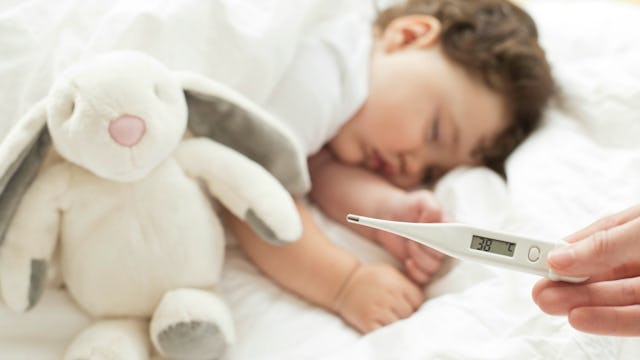Febrile Seizures: When A Fever Isn't 'Just' A Fever

Every mother knows that having a sick baby is no fun at all. Even something as simple as the common cold becomes magnified ten-fold when it’s your child experiencing the symptoms. Throw in a fever and that can be a game changer.
Navigating fevers in small children can be confusing. What temperature actually constitutes a fever? How high is too high? Should I treat with Tylenol? Ibuprofen? Both? How often? What should I do if the fever isn’t responding to medicine? Thankfully we have temporal thermometers and triage nurses to call when we have these questions. But there is one symptom of fever that no one ever told me about, so I was totally unprepared when it happened to my son. This would be the febrile seizure.
It was just another day at our house. My boys, aged three and eighteen months at the time, were playing together in the living room while I was packing lunches and bags to go to the zoo. My husband packed the cooler and wagon in the car and we were just about to load up when my youngest began to whine and cry. At this point it was getting close to nap time so I figured he was just sleepy.
We put our plans on hold and picked him up to rock him. When I picked him up I noticed he felt a little warm, so I took his temperature. His temp was around 100 degrees, so I gave him some Tylenol and sat back down in the rocker with him. I didn’t think anything else about it.
As I was rocking him he began to drift off, his sleepy little eyes closed, his body began to relax. I started to doze off myself. He twitched, which startled me, but soon we were both resting comfortably again. I felt his forehead. The medicine hadn’t had time to work yet. He twitched again, but this time was different. I felt his little body stiffen in my arms. I looked at his face and his eyes had come open, but they were rolled back in his head. His back arched, he was trembling. This was definitely not normal.
I called for my husband, “Something is WRONG! Come here now!”
He ran in and was, of course, horrified by what he saw. I told my husband I thought our baby was having a seizure. I handed the baby off to my husband and told him to watch him while I called 911. My older son was beginning to get scared. “What’s happening? What’s wrong with baby?”
My husband tried to comfort him, “It’s ok, buddy. He’s ok.” I didn’t think he was okay. I knew I wasn’t okay. This was lasting too long. The 911 operator guided me through what to do: lay him on the floor away from anything he might hurt himself on, and just let it happen. Don’t try to put anything in his mouth. Time the seizure and see how long it lasts. The paramedics were on the way.
The whole event lasted just a few minutes, but it seemed like an eternity. The seizure finally ended and my baby lay limp on the floor. I knew he was alive, but I was still so scared. Would he be the same laughing, happy boy he’d been before? Would he have brain damage? Why had this happened? I knew fevers in young children could be dangerous, but I had no idea this could happen. Why had nobody told me?
By the time the paramedics arrived, we had calmed down considerably. My son was beginning to stir, but he was lethargic. I was still too shaken up to drive so we rode in the ambulance to the children’s hospital. The nurses took my son’s temperature when we arrived at the hospital — it was 104. They administered fluids and gave him more meds to bring his temperature down. They tested him for the flu, and they told me all about febrile seizures.
Febrile seizures are seizures brought on by fever. At the time this happened, there was some debate as to whether the seizure happened because the child’s temperature got too high, or because the temperature rose too fast. One in twenty children will be have a febrile seizure in their childhood (which makes me wonder why mothers aren’t informed of this, as common as it seems), but most will outgrow them by the age of five.
My son is now seven and hasn’t had a seizure in a few years, though he did have one almost every time he got a fever when he was little. Once we knew what to do it wasn’t nearly as scary.
When your child has a seizure, first and foremost, don’t panic. The American Academy of Pediatrics says to lay your child down on the floor, or someplace where he can’t fall. Be sure the area is clear of anything that might cause your child to hurt himself. Lay him on his side to help keep his airway clear. Do not put anything in your child’s mouth. Time the seizure. Most febrile seizures last less than three minutes. Call 911 if the seizure lasts longer or your child does not regain consciousness. You child will be sleepy after the seizure. When he is fully awake, you might want to give medicine to reduce the fever, but check with your pediatrician.
Febrile seizures can be very scary, but they are not uncommon and they are usually harmless. Knowing what to do when a seizure hits can make it easier on everyone. If your child is diagnosed with febrile seizures, make sure all of his caregivers know what to do in case of seizure. Hopefully our story can help you be prepared if this should happen to your child.